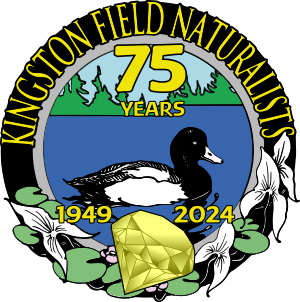
A list of all the butterfly species recorded in the Kingston Study Area is available as a Google Sheet: Butterflies of the Kingston Study Area. Use the File menu to save a copy to your Google Sheets or download the sheet in a different format.

Join or visit the KFN: Butterfly project on iNaturalist. This collection project automatically collects Butterfly observations submitted to iNaturalist that occur in the Kingston Study Area.
Butterfly enthusiasts have been observing and studying butterflies for decades in the Kingston Study Area and there is a fairly definitive list of the species that can be found in the area. If you are new to butterflies, you might be interested to know that Butterflies (Superfamily Papilionoidea) are in the Order Lepidoptera lumped together with moths. The Superfamily Papilionoidea is divided into seven families of which five families are represented in the Kingston Study Area. Butterflies are often grouped by subfamily of which 18 are represented in the Kingston Study Area.
- Skippers (Family Hesperiidae)
- Dicot Skippers (Subfamily Eudaminae)
- Grass Skippers (Subfamily Hesperiinae)
- Skipperlings (Subfamily Heteropterinae)
- Spread-wing Skippers (Subfamily Pyrginae)
- Gossamer-winged Butterflies (Family Lycaenidae)
- Coppers (Subfamily Lycaeninae)
- Insectivorous Butterflies (Subfamily Miletinae)
- Blues (Subfamily Polyommatinae)
- Hairstreaks (Subfamily Theclinae)
- Brush-footed Butterflies (Family Nymphalidae)
- Emperors (Subfamily Apaturinae)
- Milkweed Butterflies (Subfamily Danainae)
- Fritillaries and Longwings (Subfamily Heliconiinae)
- Beak and Snout Butterflies (Subfamily Libytheinae)
- Admirals and Allies (Subfamily Limenitidinae)
- Checkerspots, Anglewings, Peacocks, and Allies (Subfamily Nymphalinae)
- Satyrs, Morphos, and Allies (Subfamily Satyrinae)
- Swallowtails and Parnassians (Family Papilionidae)
- Swallowtails (Subfamily Papilioninae)
- Whites, Yellows, and Sulphurs (Family Pieridae)
- Yellows and Sulphurs (Subfamily Coliadinae)
- Whites (Subfamily Pierinae)
The Kingston Study Area is a 50 km radius circle centered on the peak of Murney Tower in Kingston, Ontario. Because the circle excludes some of Charleston Lake Provincial Park and Menzel Centennial Provincial Park is close to the edge, some KFN butterfly observers count records from those areas on their personal lists for the area.
The Kingston Field Naturalists discourages the collection of live specimens, and this may actually be illegal in certain areas (e.g. conservation areas, provincial parks, national parks). The best way to observe butterflies is with a pair of binoculars, a camera and/or a notebook. Many observers now upload their photo observations to iNaturalist. It is important that you collect date, time, and location data for your observations. Smart phone apps such as Geotag Photos Pro 2 will collect the location data for you to avoid wasting your camera battery.
Any observations added to iNaturalist get shared with the Ontario Butterfly Atlas automatically, so there is no need to submit them separately. Other observation sharing websites such as e-butterfly don’t have the same uptake as iNaturalist, but you are welcome to explore such places. Avoid duplicating observations on multiple websites or by multiple people. If you are observing butterflies with others, please decide who will upload the observations to iNaturalist. For more information about how to submit data to the Ontario Butterfly Atlas please see their “Contribute Your Ontario Butterfly Data” page.
For more information on, to learn more about, or to join someone looking for butterflies in the Kingston study area, please contact the KFN (info@kingstonfieldnaturalists.org) and your request will be passed onto the appropriate person. You can also join the Kingston Field Naturalists: Butterflies project on iNaturalist.
You may be interested in resources to help you learn about and identify butterflies in this area. The best physical field guide at present is the ROM Field Guide to Butterflies of Ontario. There is also a locally produced booklet, the Pictorial Pocket Guide to the Butterflies of the Kingston Region. To acquire one of these, please email info@kingstonfieldnaturalists.org. There are several other suggestions on the Ontario Field Naturalist’s Toolchest.
